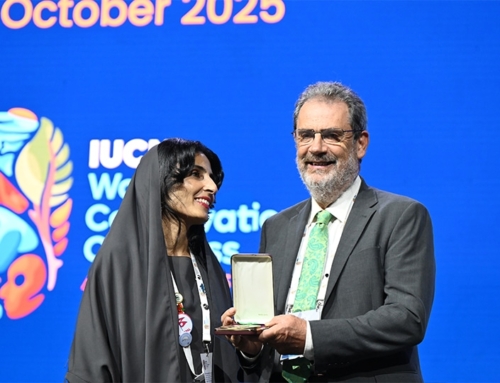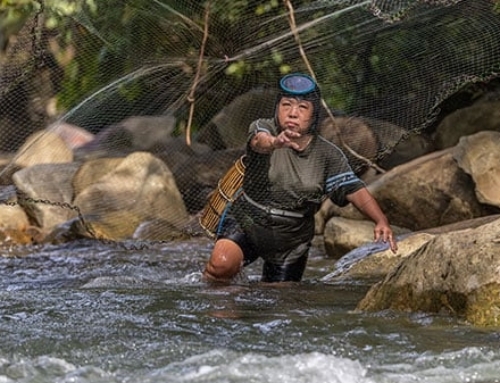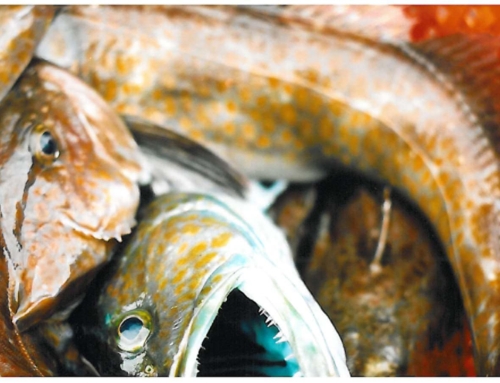The first global assessment of freshwater species across multiple taxonomic groups has revealed that one quarter of the 23,496 freshwater species surveyed by the IUCN Red List of Threatened Species™ are threatened by extinction, in a paper published by Nature.
But the scale of the freshwater biodiversity crisis told in these numbers could overwhelm the story of each species and its fight for survival. We cannot tell 23,496 stories, but we have chosen seven species across the assessment to paint a picture of the creatures behind the statistics, with the help of wildlife illustrator Van Wangye Shiming.
Underworld shrimp (Typhlocaris lethaea)
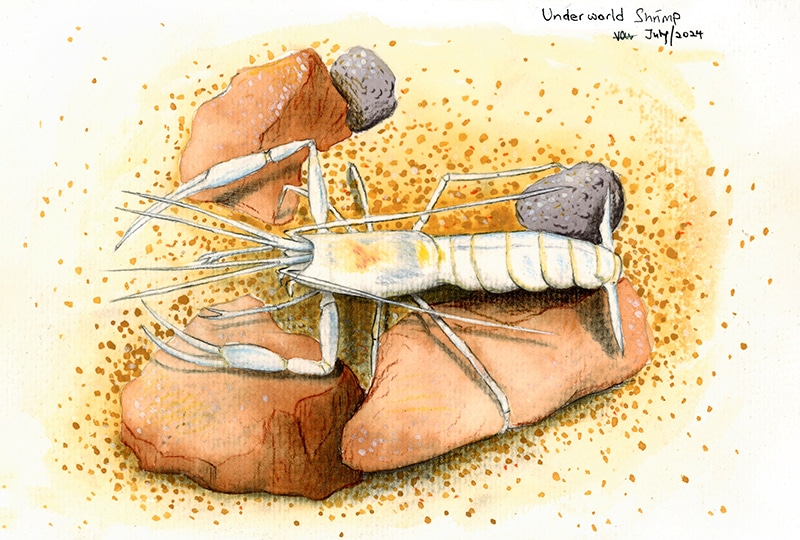
IUCN Red List Category: Data Deficient
Range: Lete Cave, Benghazi (Libya)
Population: Unknown
Habitat type: Caves
Threats: War, civil unrest & military exercises
One of the most difficult challenges in freshwater conservation is lack of research. Close to a quarter of the 23,496 species assessed did not have enough data to be sorted into an IUCN Red List category assessed their extinction risk.
It is easy to see how this can happen with a species like the underworld shrimp. It is a blind species living in total darkness, named ‘lethaea’ from the Ancient Greek ‘of the underworld’, which has only ever been found in the Lete Cave near Benghazi, Libya.
The freshwater assessment found that karst and cave systems such as the Lete Cave hosted a lot more threatened freshwater decapods (freshwater shrimp, crabs, and crayfish) than would be expected, highlighting the importance of karst (soluble rock types such as limestone, marble, and gypsum) and cave habitats.
Asian sapphire flutterer (Rhyothemis triangularis)

IUCN Red List Category: Least Concern
Range: East and Southeast Asia
Population: Unknown, but common across range
Habitat type: Permanent freshwater marshes/pools, artificial ponds, canals, drainage channels, ditches
Threats: None
‘Least Concern’ is the IUCN Red List category we aspire all species to be. The species population is healthy and abundant with sufficient habitat within its range and is unlikely to be threatened in the near future.
The stunning Asian sapphire flutterer is a common sight across East and Southeast Asia. Our illustration depicts this iridescent hunter on a pink lotus to represent those found in Lake Sebu, a place where the dragonflies hold great cultural significance to the local T’boli people. Dragonfly larvae are an important food source for older generations and are believed to make a person intelligent, prevent aging, and cure diseases (medicinal use requires certain ritual rather than straightforward consumption).
The T’boli believe that dragonfly larvae can cure diseases because they thrive in freshwater. For them, water signifies cleanliness, which in turn cleanses the body and prevents illnesses.
Socotra Bluet (Azuragrion granti)

IUCN Red List Category: Near Threatened
Range: Socotra (Yemen)
Population: Unknown, but locally abundant
Habitat type: Mountain rivers, freshwater springs, and oases
Threats: Overgrazing of the valleys, agricultural run-off, climate change, and invasive species.
A key factor that affects a species’ conservation status is where it can be found. Areas which are isolated by geographic barriers such as ocean (islands) or altitude (mountains) have provided rich opportunity for evolution to drive an abundance of unique species (known as ‘endemic’) which cannot be found anywhere else.
These species are particularly vulnerable because they are entirely reliant on the health of a limited habitat range, and protecting such species usually requires specific actions on the local level to ensure their survival. The Socotra Bluet is naturally predated by another of Socotra’s endemic species, the Socotra Freshwater Crab, but it faces an additional threat due to an introduced fish species which feeds on the adults.
It is also highly sensitive to pollution, and its waters are becoming over-polluted with nutrients from agricultural run-off. Climate change is also a threat as landslides or disruptions to river flow from cyclones, droughts, and floods could cause significant changes to their habitat.
Australian freshwater tiger crab (Austrothelphusa tigrina)
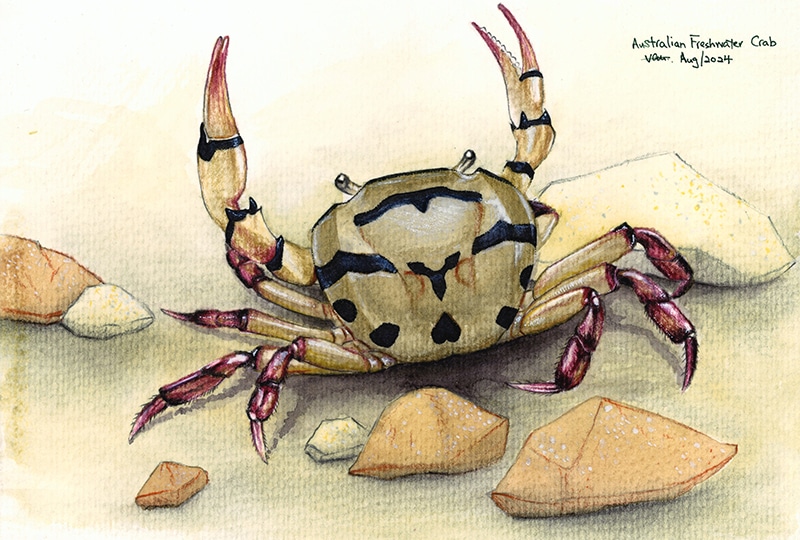
IUCN Red List Category: Vulnerable
Range: One Mile Creek, Queensland (Australia)
Population: Unknown but during the wet season, crabs number in their thousands in shallow water.
Habitat type: Shallow rivers, streams and creeks during the wet season, and occupy sandy burrows in the dry season.
Threats: Future mining.
This tiger crab’s Vulnerable status shows how important it is for the IUCN Red List to forecast impending threats, even if they are not yet affecting a species. Although these crabs are seen in their thousands during the wet season in One Mile Creek, this area (its only known habitat) is currently leasehold pastoral land and lies largely within the Alice River Mining Field, so gold mining is a foreseeable severe threat to its future.
Freshwater crabs, with 1280 species, represent one-fifth of all the world’s true crabs. Only one-third are not at-risk, and although none have been confirmed extinct, almost half are too poorly known to assess.
Conasauga blue burrower (Cambarus cymatilis)
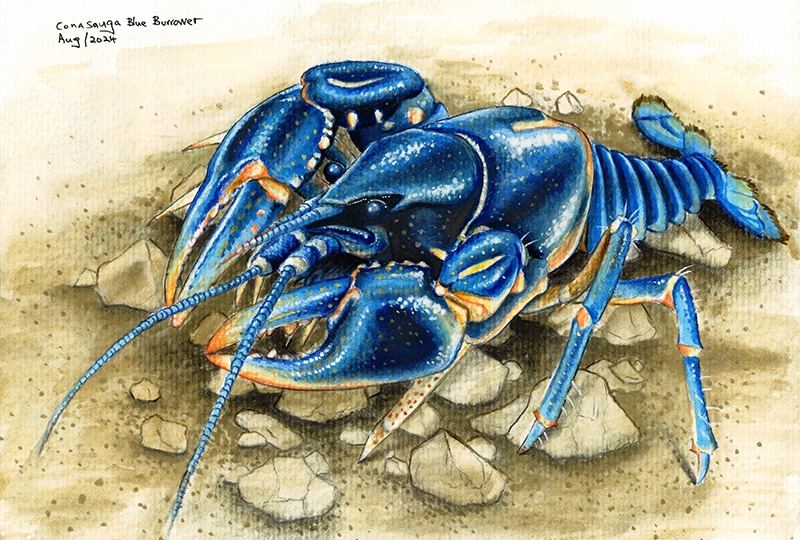
IUCN Red List Category: Endangered
Range: Tennessee, Georgia (United States)
Population: Unknown, with four known localities
Habitat type: Elaborate burrows in open, damp, grassy areas, commonly burrowing in gardens.
Threats: Habitat deterioration and loss.
This striking species is named after the Conasauga River, a name derived from the Cherokee language meaning “grass”, as the Cherokee Nation had sovereignty over the river and the land surrounding it until the 1830s. The Conasauga River’s aquatic biodiversity is unique across North America, with more than 90 different species of fish and 25 species of freshwater mussels.
However, of North America’s freshwater wildlife, crayfishes are among the most imperilled animal groups. Of the four known locations for this Endangered species, three of them are threatened: one site is in the yard of a homeowner in a city neighbourhood; one has been partially paved over; the other is currently being used for cattle grazing and is in bad condition.
But conservation efforts are focusing restoration work on Holly Creek, an idyllic-looking tributary of the Conasauga, which is alongside one of the key known sites for the Conasauga blue burrower.
European eel (Anguilla anguilla)

IUCN Red List Category: Critically Endangered
Range: Europe, North Africa, and Sargasso Sea
Population: Complex life cycle and lack of data make population research particularly difficult but a decline in adults has been recorded.
Habitat type: The species is found in a range of habitats from small streams to large rivers and lakes, and in estuaries, lagoons and coastal waters. It also occupies open ocean areas during migrations and breeding but is rarely observed in this habitat.
Threats: Barriers to migration, climate change, habitat loss/degradation, invasive species, parasitism, pollution, predation and unsustainable exploitation.
Aristotle believed that eels were born spontaneously from the mud. An old Scottish belief was that they began their lives as beetles. Famed Austrian neurologist Sigmund Freud began his career searching for the testis in male eels and dissected hundreds of eels for four months… to no avail.
For thousands of years humans found no eggs, young, or sexual organs for the eel, and so it has become one of zoology’s most intriguing mysteries. It was Danish marine biologist Johannes Schmidt who finally solved (some) of the puzzle of the eel’s origins by tracing the leaf-like larvae across the Atlantic to the Sargasso Sea in 1930.
But it is not just scientifically important – the European Eel has long had fascinating cultural importance across its range. In ancient Egypt, the eel was considered a mighty demon, an equal to the gods and a forbidden food. Eel fishing has many traditions and has shaped coastal communities and cuisines, from the klumma fishing technique in southern Sweden to the trade between Lough Neagh fishers in Northern Ireland to London, where eels were sold cheaper than meat, making it a staple of London’s working class in the East End.
However, as a migratory species with a range across the European continent in both freshwater and marine waters, eel conservation represents the importance of international cooperation. There is an EU-wide recovery plan for the European Eel, as well as a systematic monitoring scheme and harvest management plan, supported by international agreements and efforts such as the Convention on Migratory Species and the IUCN SSC Anguillid Eel Specialist Group.
Furthermore, the trafficking of glass eels has been called one of the most substantial and lucrative illegal trades of protected species across the globe, with illegal profits estimated to be up to EUR 3 billion in peak years. Several criminal networks are responsible for trafficking these fish from Europe to Asia. Operation LAKE targets the trafficking of the European eel in its ‘glass eel’ life stage.
Golden skiffia (Skiffia francesae)

IUCN Red List Category: Extinct in the Wild
Range: Río Teuchitlán, Jalisco (Mexico), reintroduced in 2022.
Population: Approximately 1,200 individuals were released in the reintroduction.
Habitat type: Quiet, thermal and shallow waters.
Threats: Invasive species, hydropower dam, and habitat degradation.
Conservation works. Conservation action, driven by robust data and widely available research such as the IUCN Red List, can cause species to move back from the brink of extinction.
When the golden skiffia was classified as Extinct in the Wild in 2018, it had not been seen in the Río Teuchitlán since the 1990s. Invasive species make up to 95% of the individuals in the spring area of Teuchitlán, causing huge declines in native fishes like the skiffia. The river has been degraded due to the construction of the La Vega Dam, springs being turned into spas, and habitat degradation has confined the remaining species in the skiffia’s family (goodeids) to a small area at the river headwaters.
However, our partner SHOAL, the University of Michoacan, Chester Zoo, the Goodeid Working Group and a host of other organisations are working together on a conservation plan for each of the threatened Mexican goodeids, and the golden skiffia’s status is due an update following its reintroduction to the Río Teuchitlán.
The reintroduction was a beautiful event. Two days after the Mexican celebration of Día de los Muertos, the meaning of life and death strong in their minds, the release of the first 10 individuals was marked by a day-long cultural celebration on November 4th 2022. To the sound of rhythmic drumming, local children released 10 skiffia individuals one at a time. A total of 1,000 skiffia were released, tagged with a non-toxic elastomer before release and will be monitored for the next five years.
Synchronicity Earth specialises in supporting overlooked challenges in conservation. The Global Freshwater Fauna Assessment represents not only a fundamentally under-funded group of species and ecosystems, but also the importance of research to drive effective conservation action.
Our Freshwater Programme has supported the IUCN Biodiversity Assessment and Knowledge Team (BAKT) for 11 years, and although this research provides a stark wake-up call, we are so proud of their achievement in publishing this vital paper.
If you are interested in supporting this work, please get in touch.



